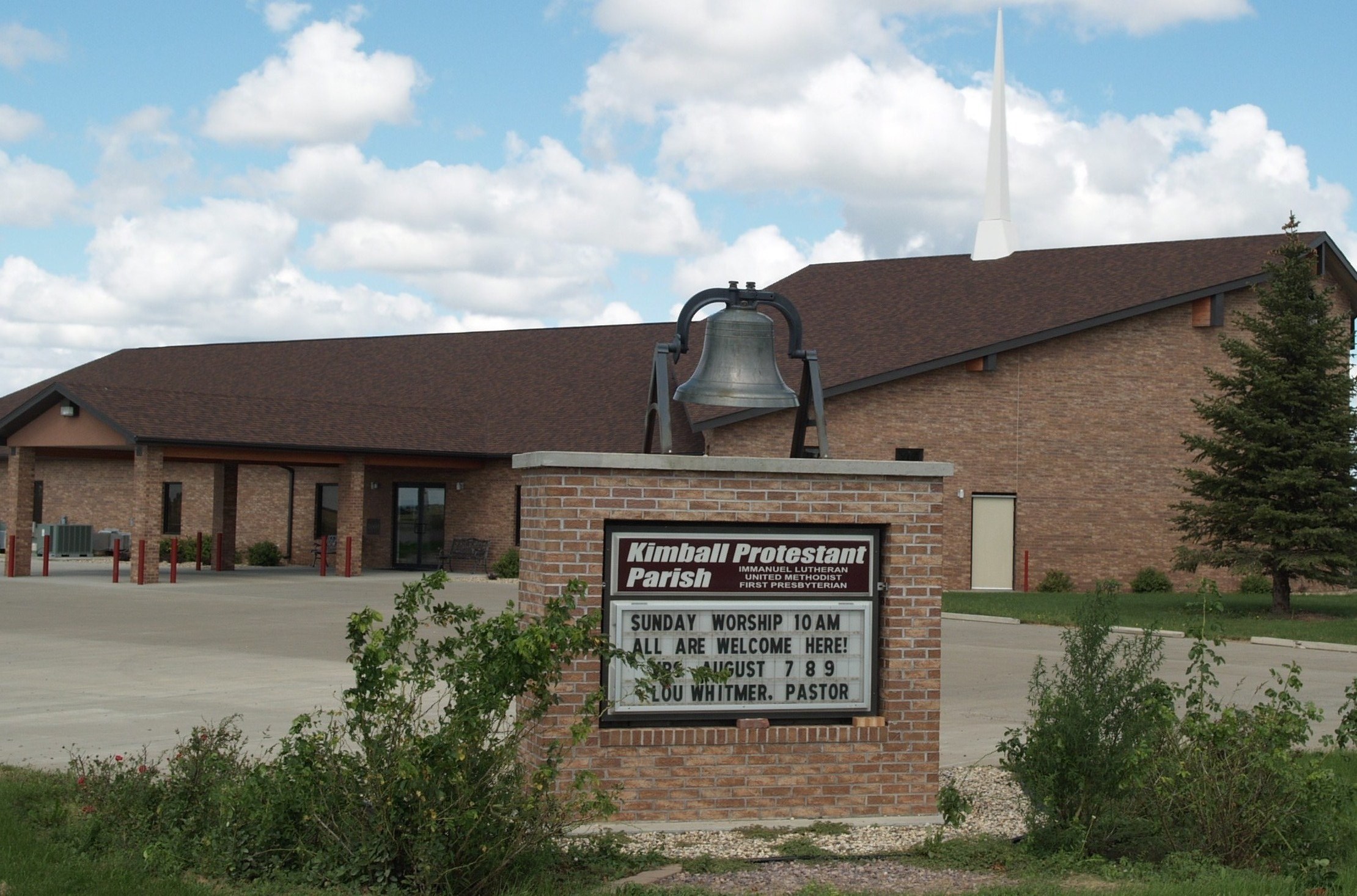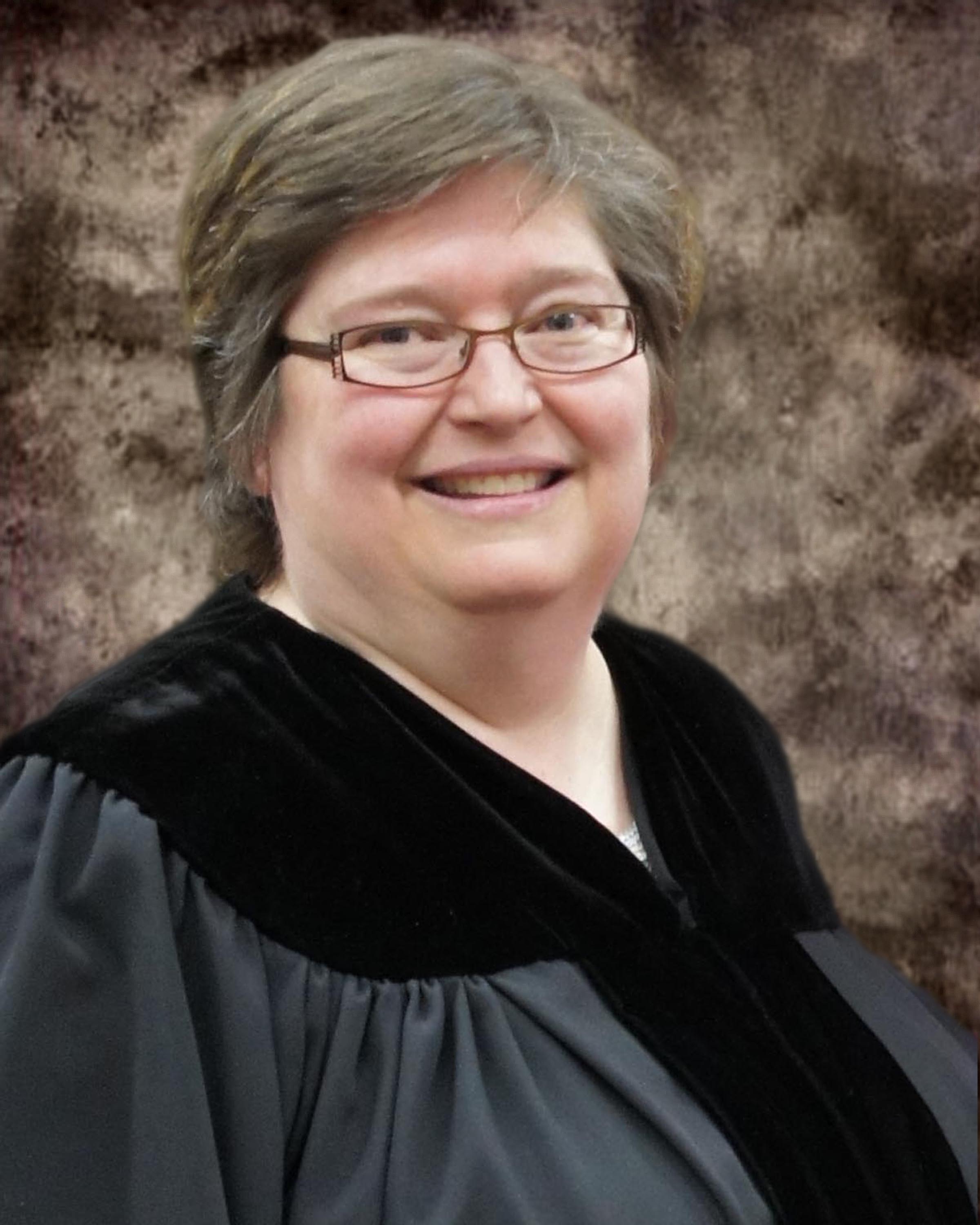The Rev. Nancy Manning serves a three-point parish—United Methodist Church in Britton, Claremont (S.D.) United Methodist and Hecla (S.D.) United Methodist. Photo by The Britton Journal
By Heidi Marttila-Losure, Dakotafire Media
Reporting by Doug Card, Britton Journal, and Melody Owen, Tri-County News
The United Church of Christ in Gackle, N.D., is a traditional church building with angels in its stained glass windows; a few blocks away, Grace Baptist Church has a more modest style, and could blend in with the residences around it if not for the steeple on the rooftop.
But despite their differences, the two churches do share one thing: the Rev. Tim Blackman’s presence on Sunday mornings.

The Rev. Tim Blackman serves both the United Church of Christ, left, and Grace Baptist Church in Gackle, N.D. Photos by Tri-County News

Which way, in faith?
This is the second in a three-part Dakotafire series about the challenges facing our rural churches.
See the other two stories in the series:
Blackman and his wife, Marilyn, moved to Gackle in March 2004 to serve at Grace Baptist. At that time, the Gackle United Church of Christ (UCC) together with UCCs in Streeter and Jud supported a full-time minister. But a few years later, both the Streeter and Jud churches closed due to low attendance, and the Gackle church alone could not bear the financial cost of a full-time pastor.
When the UCC pastor left, Blackman was asked to preach on some Sundays, alternating with another local minister. In the spring of 2007, Blackman was asked if he would consider becoming their regular pastor.
There was an additional hoop to jump through: Blackman had to meet with a special state denomination committee after he was called by the Gackle UCC. Then he was licensed with the UCC.
The cross-denominational arrangement is going well. The only drawback from Blackman’s point of view is that he has to miss Sunday School when he heads to the second service.
“I like Sunday School,” he said with a smile.
Across the Dakotas, rural churches are struggling with declining membership, trying to discern what the next step is for their congregations. Many, like these two in Gackle, have found an answer in partnering with another nearby congregation—or perhaps several. For others, partnering is not a viable option, and they have to find some other solution or face closing their doors.
Whatever lies ahead for them is going to require some courage: a leap of faith.
Attitude makes change possible
Starting a year and a half ago, the Rev. Nancy Manning has had three churches to tend to on Sunday mornings: United Methodist in Britton, Claremont United Methodist and Hecla United Methodist. She had been serving in Claremont and Hecla when Britton Methodist decided it could no longer support a full-time pastor.
The process of joining the three churches took about nine months, Manning explained. “Part of it was financial, part of it was numbers, and part of it was the needs of the churches,” she said.
But now that the arrangement is in place, it’s working quite well—though it does keep Manning hopping.
“The biggest challenge is time and distance,” Manning said. “All three churches are about 22 miles apart, so there is no lollygagging on Sunday morning. Many pastors get to spend time with people after worship, but I’m only able to do that at one. Then visitation becomes even more important.”
The key to making a new partnership work is whether people have a good attitude about it.
“If they are willing to be flexible in some things and willing to try things that haven’t been their tradition, it makes a significant difference,” Manning said.
Even little things can cause big problems if they are allowed to be: Worship times, for example. In the new partnership, once church had to change 15 minutes, another 45 minutes, and the last a half-hour.
But “when you’ve been doing it a certain way forever and ever, that is a big deal,” Manning said. “For some of the smaller churches, if they are not willing to be flexible, the only other real alternative is to close.”
The Rev. John Erbele, lead pastor of Recharge Church in Gackle, said he thinks rural churches are often set in their ways. But as in business and even in farming today, keeping up with changes and technology is the key to being successful. That doesn’t mean losing what’s important, however: “Don’t change the message—change the methods,” he said.
That’s especially important if churches want to draw in young people, he added.
Scaling denominational walls
Churches within the same denomination have been forming joint parishes in rural Dakota communities for many years as membership numbers have dwindled. In recent years, however, even those joint arrangements have not brought together enough resources to cover the cost of a pastor.
The Rev. Keith Zeh, Director for Evangelical Mission in Eastern N.D. and Northwestern Minn. Synods in the Evangelical Lutheran Church of America, suggests that looking beyond denominational dividers can be an answer.
“It’s really good to put our heads together with our full ecumenical partners, those that we have a relationship with where we can share pastors back and forth,” Zeh said. “Sometimes when we take a look outside our own denomination, and vice versa, that’s also very helpful.”
For example, ELCA churches can be led by pastors who are United Methodist, Presbyterian or Episcopalian, Zeh said.

Kimball Protestant Parish in Kimball, S.D. Photo from www.protestantparish.org
One example of such an arrangement is the Kimball Protestant Parish in Kimball, S.D., 22 miles east of Chamberlain on Interstate 90.

Pastor Laurie Kidd. Photo from www.protestantparish.org
The majority of churchgoers in the town of 700 are Catholic; other churches have always been a smaller presence, explained the Rev. Laurie Kidd, pastor of Kimball Protestant Parish. The Methodist and Presbyterian churches had been worshiping together for 40 years, and sometime before 2003, the ELCA congregation in town joined their partnership. Their new church building was built in 2003. Formalizing the agreement has been a more recent endeavor: The three churches voted to join together as a unity church on Sept. 11, 2011, and just this past Sunday they voted on their bylaws.
Kidd said the united church is working well, but there were some concerns to address in the transition. Some members had a hard time letting go of some established traditions.
“In my mind, we have one boss—God is our boss,” Kidd said. “We tried to stress to them, ‘You are not going to lose your soul or your identity as either a Lutheran, a Methodist or a Presbyterian. All this really affects is how you keep records.’”
The church is now recognized as a unity church by all three larger church bodies. Accounting of income, attendance and so on is divided by three, so that a third is reported to each larger organization.
The sanctuary has items from all the three churches, and a grand total of five hymnals: one from each of the faith traditions, plus supplements for the Methodist and Presbyterian hymn books. They sing songs from each of them—and occasionally praise and contemporary songs that aren’t in any of them.
Kidd herself is from a Disciples of Christ background but became Methodist in 2000. The labels don’t mean much to her. “I’m one of those that denomination to me doesn’t make a difference,” she said. “It’s just about serving the one God.”
Facing closure
What if a church isn’t able to find a way to co-op? At what point does a church need to face the possibility of closure?
A recent article in The Lutheran magazine discussed the situation in the ELCA, where more than 1,000 churches have closed in the past 10 years.
“If you have 12 people on a Sunday, you could be wonderful, spiritual folks, but I’m not sure how viable you are,” Elizabeth Eaton, bishop of the ELCA’s Northeastern Ohio Synod, was quoted as saying in the article. “When you get to be so small that you can’t pay the bills, people just get tired.”
When the only option left is closing the doors, it’s important to allow the members to go through a grieving process, the article explained. Closing a church can be akin to a death in the family.
“One thing we can do is help (congregations) find space for lament,” said “William Gafkjen, bishop of the Indiana-Kentucky Synod, said in The Lutheran article. “Just reminding them that we are a Good Friday, Holy Saturday, Easter Sunday kind of people and that there is always promise on the other side of death, whatever death is.”
For some churches, the way to bring a positive out of a sad situation could mean using their resources to support some other worthwhile endeavor in the community.
That decision is a few years off for many churches in the rural Dakotas. They are surviving, for now—but they are struggling to keep the basics of the church in place, and often there is not much joy in that situation.
Those churches need to ask themselves some discerning questions, according to Zeh.
“That survival mentality, it’s understandable,” Zeh said. “But surviving for what purpose? Why survive? Get after that. Get a renewed sense of calling—no matter how small the community is, they could and can make a difference. If they can see that, they can get more excited and more positive about who they are and what they can do. And then they are more ready to face the on-the-ground challenges.”
See the other two stories in the series:
 Dakotafire Get your spark here.
Dakotafire Get your spark here.



